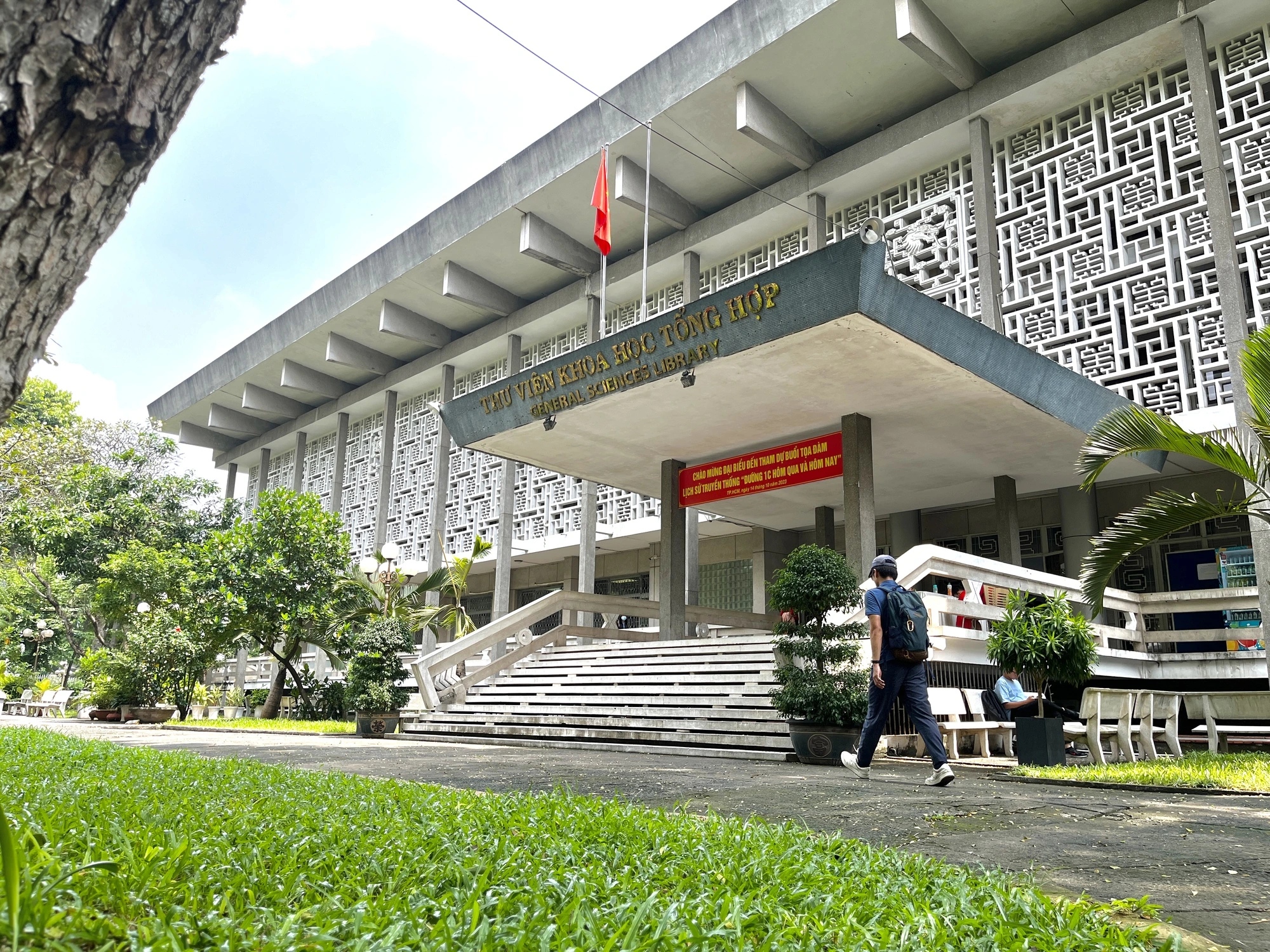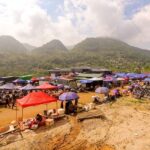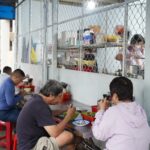Walking through the bustling streets of Ho Chi Minh City, one can’t help but feel immersed in a multilayered conversation between the modern and the traditional. Amid the contemporary facades, there lies a hint of classic elegance; within the integrated lifestyle, one can still savor the essence of century-old contemplations. This unique blend has not only shaped the city’s distinct charm but also stands as a testament to its commitment to preserving traditional cultural values, adapting with graceful flexibility to societal evolution.

A weekend morning in Ho Chi Minh City. Photo by David Style.
These were my reflections as I signed up for a walking tour to explore the city’s architectural heritage. On a typical wet weekend, characteristic of the rainy season, I hurried out of my house, questioning my decision to venture out into the drizzling rain.
That day, our group gathered in front of the Youth Cultural House on Pham Ngoc Thach Street. After a brief explanation of the itinerary, our guide began by providing an overview of the development of modern architecture (modernism) in Ho Chi Minh City during the 1940s to 1970s.
Inspired by Western modern architecture and infused with unique Vietnamese elements, this movement aimed to withstand the relentless tropical climate. Notable architects of this “modernism era” include Huynh Tan Phat and Ngo Viet Thu, among others, who created many special structures that still stand prominent in the city today.
Reunification Hall | 135 Nam Ky Khoi Nghia, Ben Nghe Ward, District 1
We walked through the 30/4 Park towards the Reunification Hall, unfazed by the gentle drizzle. Standing before the vast compound, our guide allowed our group to take photographs before commencing the tour.

The Reunification Hall showcases the face of modern architecture. Photo by Andrey X.
For a true Saigonese, the Reunification Hall is a familiar landmark. This masterpiece was designed by architect Ngo Viet Thu, the first Vietnamese recipient of the prestigious Grand Prix de Rome award in 1955. He seamlessly blended modern and traditional East Asian architecture by incorporating auspicious Chinese characters into the overall design.
The building’s facade draws inspiration from the image of bamboo. Our guide explained that the double-layered facade is a distinctive feature of Vietnamese modern architecture, serving as a solution for tropical countries and a canvas for architects to showcase their creativity.
The brise soleil, a technique to reduce solar heat gain, was designed by sculptor Nguyen Van The, featuring concrete details that resemble bamboo stalks, forming a curtain with nine leaf-shaped openings, reminiscent of the traditional bamboo blinds found in ancient Southern Vietnamese homes.

The brise soleil, crafted from concrete bamboo stalks, acts as a heat shield for the building. Photo by Andrey X.
Ho Chi Minh City General Science Library | 69 Ly Tu Trong, Ben Thanh Ward, District 1
Spanning approximately 7,000 square meters, the Ho Chi Minh City General Science Library stands as another exemplary showcase of modern architecture in the city. With its robust form and intelligent natural ventilation system, the library is not just a repository of knowledge but also an architectural work of art.

The Ho Chi Minh City General Science Library. Photo by Huynh Nhi.
Constructed from 1968 to 1971 by architects Nguyen Huu Thien and Bui Quang Hanh, with technical advice from architect Le Van Lam, the library impresses with its intricate and detailed design, even to those untrained in architecture.

The library’s interior showcases a complex and detailed design. Photo by Kate Tipler.
According to our guide, the library’s facade is steeped in Eastern influences, drawing inspiration from stylized Chinese characters such as the character for longevity and the yin-yang symbol. Additionally, the building incorporates the four spiritual animals—the Azure Dragon, the Vermilion Bird, the Black Tortoise, and the White Tiger—symbolizing harmony, prosperity, and success in feng shui. Notably, the double-layered facade is employed to mitigate the impact of external heat, providing a comfortable reading environment during both the dry and rainy seasons.

The brise soleil at the library incorporates stylized Han characters and the four spiritual animals. Photo by Lee Starnes.
V.A.R Building | 9-19 Ho Tung Mau, Nguyen Thai Binh Ward, District 1
Our final destination on this nearly three-and-a-half-hour walking journey was the V.A.R. building, a testament to modern style and Vietnamese ingenuity in the city during the late 20th century.
Located at the intersection of Ho Tung Mau and Nguyen Cong Tru streets, the building’s facade immediately captures attention with its distinctive double-layered shell, a hallmark of modern architecture that demands technical prowess, executed with finesse by architect Le Van Lam, reflecting his consideration for the tropical climate of this bustling metropolis.

The V.A.R. building at the corner of Ho Tung Mau and Nguyen Cong Tru streets. Photo by Alberto Prieto.
The concrete brise soleil, or sun-shading device, consists of a system of slender horizontal and vertical concrete elements interconnected, rotating, and interchanging in a skillfully calculated rhythm, creating a unique dynamic effect through visual transitions and showcasing the architect’s aesthetic sensibility in contrast and three-dimensional composition.
The building’s finishing materials, including washed stone, cut stone, and mosaic tiles, contribute to its harmonious overall appearance while protecting its components from various environmental impacts. Perhaps this is why, after weathering countless seasons, the V.A.R. building still stands strong, witnessing the city’s astonishing transformations.

The brise soleil, a hallmark of modern architecture, is elegantly incorporated into the V.A.R. building’s design. Photo by Alberto Prieto.
As I bid farewell to this walking tour, I couldn’t help but feel enriched with newfound knowledge about the city that bears Uncle Ho’s name, a place that constantly evolves to keep pace with the times. Yet, amidst this frantic whirl, it’s heartening to witness classical structures, breathing the air of bygone days, standing alongside positive progress. They serve as reminders of the dexterity, hope, and resilience of the Vietnamese people, particularly the Saigonese, through countless vicissitudes.
The past is not merely what lies behind; it is a source of inspiration for future breakthrough creations. Each architectural masterpiece encapsulates the wisdom and soul of the Vietnamese people. By exploring and valuing these treasures, we can uncover new ideas and perspectives, enriching the spiritual values of Ho Chi Minh City in a way that is imbued with national identity. Thus, we create a compelling draw for adventurous travelers from distant lands.
The Dawn of a Unique Buffalo Market in Lao Cai: A Pitch-Black Herd at Dawn
The Can Cau Cattle Market is a captivating destination in Lao Cai Province. This vibrant market is renowned for its lively trade of hundreds of cattle, brought by locals from distant villages. The scene is a kaleidoscope of colors, with Hmong and Giay youths gracefully flocking to the market, creating a unique and enchanting atmosphere in this far-flung border region.
The ‘Treasure’ in the Incense-less Temple, Once Ranked Among the World’s Most Beautiful.
The architectural masterpiece, a temple that never lights incense, has become a popular attraction for locals and tourists alike. With its unique design and ambiance, it offers a tranquil escape from the bustling city life, providing a space for reflection and contemplation. The temple’s aesthetic appeal and serene atmosphere have captivated many, making it a must-visit destination.
The Heart of Saigon’s 3 a.m. Market: A 50-Year Legacy Built on a Single Trade
Chợ Lưu Xuân Tín is a renowned wholesale and retail supplier of ornamental fish in Ho Chi Minh City and its surrounding provinces, including Binh Phuoc, Tay Ninh, Dong Nai, Binh Duong, and Long An. We pride ourselves on being the go-to source for both traders and enthusiasts alike, offering a wide range of exotic and beautiful fish to suit any aquarium or pond. With a strong focus on quality and customer satisfaction, we strive to be the leading provider of vibrant and healthy fish, ensuring that our customers can always find what they need to create their dream aquatic habitats.






































